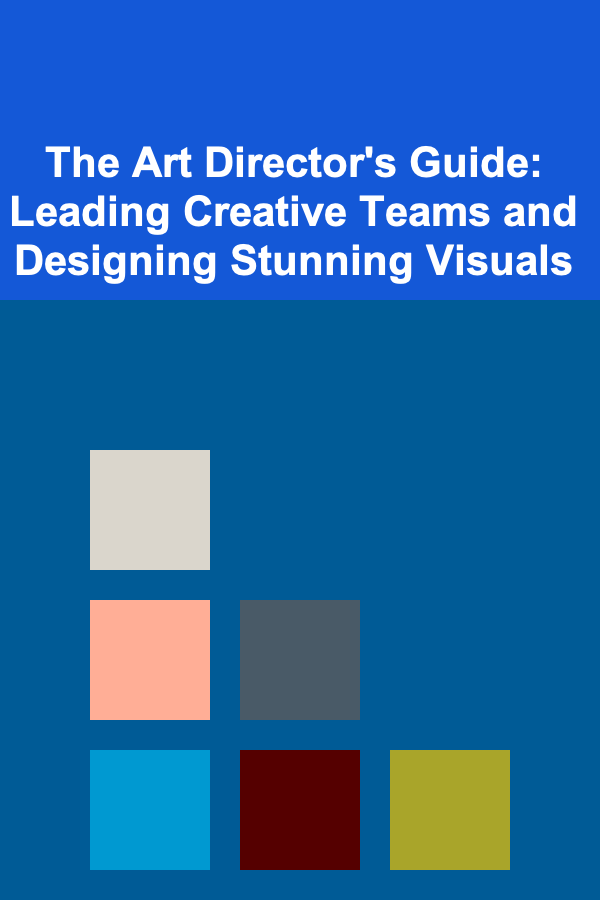
The Art Director's Guide: Leading Creative Teams and Designing Stunning Visuals
ebook include PDF & Audio bundle (Micro Guide)
$12.99$9.99
Limited Time Offer! Order within the next:

In the world of design, the role of an art director is crucial in bridging creativity with execution. An art director leads the visual direction of projects, ensuring that the aesthetic goals align with the broader strategy of the brand or campaign. Whether working on advertising, branding, film, digital media, or any other creative field, the art director's role is pivotal to crafting compelling visuals that resonate with audiences and leave a lasting impact.
This guide aims to provide actionable insights into the art director's multifaceted role, offering strategies for leading creative teams, designing stunning visuals, and fostering a collaborative environment that brings ideas to life.
Understanding the Role of an Art Director
Art directors are responsible for the overall visual style and imagery of a project. They work closely with other creatives such as graphic designers, copywriters, photographers, illustrators, and digital specialists, ensuring that each element contributes cohesively to the final product.
The primary goals of an art director include:
- Developing the visual concept for a project.
- Ensuring that the visual elements are consistent with the brand or message.
- Collaborating with various stakeholders to bring ideas to life.
- Managing creative teams and fostering an environment where innovation thrives.
- Overseeing the production process, ensuring quality control and timely delivery.
A great art director not only has an eye for detail and design but also possesses leadership qualities that allow them to guide their teams through challenges and inspire creativity. Their role is not just about creating beautiful images, but about translating ideas into compelling visual stories.
Leading Creative Teams: Building a Collaborative Environment
As an art director, leadership skills are just as important as creative prowess. You will be responsible for bringing together a diverse group of people with different skill sets and creative visions. Creating a collaborative, supportive environment is crucial for delivering great work.
1. Set Clear Expectations and Goals
A successful project begins with clear expectations. As the art director, you need to set the tone for the team by defining the goals and vision for the project early on. Whether it's for a campaign, branding initiative, or product launch, everyone should understand the creative direction, deadlines, and scope of work.
Key steps include:
- Communicating the project's overarching objectives.
- Setting realistic timelines and milestones.
- Defining each team member's role and responsibilities.
- Ensuring alignment between stakeholders, including marketing teams, clients, and other departments.
By having a well-defined vision and clear objectives, you help guide your team towards the desired outcome, minimizing confusion and inefficiency.
2. Foster Creativity and Innovation
While art direction is about maintaining consistency, it's also about pushing the boundaries of creativity. Encourage your team to experiment and bring fresh ideas to the table. The best work often comes from collaboration and risk-taking.
To foster a creative environment:
- Encourage brainstorming sessions where no idea is off-limits.
- Create space for team members to contribute their unique perspectives.
- Stay open to unconventional solutions that may challenge traditional design norms.
By nurturing creativity, you allow your team to explore new concepts, leading to innovative and stunning visual outcomes.
3. Build a Diverse Team
Diversity in a creative team often leads to richer, more varied ideas. As an art director, you should prioritize building teams that bring diverse perspectives, backgrounds, and skills. This diversity enables you to approach challenges from different angles and produce more well-rounded work.
When building a team, consider:
- Including people with different expertise, such as photography, motion design, typography, or 3D design.
- Hiring individuals who bring different cultural perspectives and life experiences to inform your visual storytelling.
- Encouraging collaboration between team members with varied design philosophies.
A diverse team can create more inclusive, relevant, and impactful visual work that resonates with a broader audience.
4. Provide Constructive Feedback
One of the most critical skills of an art director is the ability to provide constructive feedback. Feedback is essential for refining ideas and ensuring that the creative output aligns with the project's objectives. The key is to offer feedback that is specific, actionable, and framed positively.
When giving feedback:
- Be clear about what works and what doesn't in the design.
- Focus on how improvements can be made, rather than what's wrong with the work.
- Offer suggestions that are solutions-oriented, rather than simply pointing out problems.
- Be mindful of tone and encourage an open dialogue where team members feel comfortable discussing their ideas.
Effective feedback ensures that your team members continue to grow and that the final visuals meet the high standards you set.
5. Empower and Trust Your Team
As a leader, it's essential to trust your team's abilities and give them the autonomy to make decisions. Micromanaging can stifle creativity and reduce morale. Empower your team by offering guidance and direction while allowing them the freedom to execute their ideas.
Encourage autonomy by:
- Allowing team members to take ownership of their tasks.
- Offering guidance, but stepping back when necessary to let them explore ideas.
- Providing resources and support but allowing room for independent decision-making.
Trusting your team helps them grow professionally and contributes to a more innovative and dynamic work environment.
Designing Stunning Visuals: The Art of Crafting Engaging Imagery
As an art director, your ultimate responsibility is to create visuals that captivate and communicate effectively. This requires a blend of artistic sensibility, technical skill, and an understanding of the brand and audience you are designing for.
1. Start with Concept Development
Before jumping into the design process, it's important to define the concept that will guide your visuals. This phase is about brainstorming, sketching, and discussing ideas with your team. The goal is to ensure that every visual element contributes to the narrative you want to tell.
- Create mood boards or visual references that illustrate the look and feel of the project.
- Define the color palette, typography, and other design elements that align with the concept.
- Sketch rough drafts to experiment with layouts and composition.
By establishing a strong concept early on, you ensure that every element in the design serves a clear purpose and supports the overall vision.
2. Focus on Composition and Balance
Composition is the backbone of any good design. It dictates how visual elements are arranged on the page, screen, or canvas and ensures that the design is aesthetically pleasing and effective in communicating its message.
Consider the following when working on composition:
- Rule of thirds: Break the design into a grid and place key elements along the lines or intersections to create balance.
- Hierarchy: Ensure that the most important elements are visually emphasized through size, color, or placement.
- White space: Don't overcrowd the design. Use negative space effectively to give elements room to breathe and improve readability.
A well-composed design enhances the user's experience, guiding their eyes through the visuals and highlighting important messages.
3. Incorporate Typography and Visual Storytelling
Typography is a crucial component of any visual design. It can elevate the overall aesthetic and contribute to the emotional tone of the piece. As an art director, you must choose typefaces that align with the concept and message.
When working with typography:
- Choose fonts that reflect the brand's voice and personality.
- Pay attention to legibility, especially when working with long texts.
- Use font weights and sizes to establish hierarchy and guide the viewer's eye.
Additionally, effective visual storytelling goes beyond the words. Use imagery and design elements that complement the message and evoke emotions. Whether it's through photography, illustration, or graphic elements, ensure that the visuals tell a compelling story that resonates with your audience.
4. Utilize Color Theory
Color plays a vital role in shaping the mood and tone of a design. Understanding color theory allows you to choose palettes that create harmony and contrast while also aligning with the project's goals.
When selecting colors:
- Consider the psychological effects of colors (e.g., blue for trust, red for excitement).
- Create contrast by pairing complementary colors or using one dominant color with accents.
- Be mindful of color accessibility, ensuring that your design is inclusive for people with color blindness.
The right color scheme can make a design pop, establish mood, and reinforce the message you want to convey.
5. Iterate and Refine
The first draft of a design is rarely perfect. Iteration is a crucial part of the design process, as it allows you to refine and improve the work. As an art director, you should be comfortable revisiting and adjusting your designs based on feedback, new ideas, or emerging insights.
- Regularly review designs with your team and stakeholders.
- Make refinements to improve the composition, typography, color, and other design elements.
- Don't be afraid to discard ideas that aren't working and explore new directions.
Iteration ensures that the final design is polished and effective, meeting both creative and functional goals.
Conclusion: Mastering the Art of Art Direction
Being an art director is about more than just creating visually stunning designs. It's about leading a team, nurturing creativity, and ensuring that every design decision contributes to the larger vision of the project. By fostering a collaborative environment, setting clear goals, and mastering the fundamentals of design, art directors can guide their teams to create visuals that captivate, inspire, and communicate effectively.
In today's fast-paced creative industry, the art director's ability to balance creativity with leadership and technical skill is key to producing standout work that resonates with audiences and elevates brands. Whether working on digital campaigns, print materials, or film projects, the principles of great art direction remain constant: clarity, collaboration, and creativity.
Reading More From Our Other Websites
- [Metal Stamping Tip 101] From Concept to Press: A Step‑by‑Step Guide to CAD‑Driven Metal Stamping Workflows
- [Home Storage Solution 101] How to Organize Your Sports Equipment for Maximum Storage Efficiency
- [Personal Care Tips 101] How to Choose Sunscreen That Matches Your Outdoor Activities
- [Personal Investment 101] How to Create a Passive Income Stream Through Investments
- [Survival Kit 101] Top 5 Best Fire Starters for Survival Kit: Must-Have Gear for Preppers
- [Organization Tip 101] How to Use Plant Tags for Easy Identification
- [Organization Tip 101] Best Zero‑Waste Organization Solutions: Decluttering Sustainably & Minimizing Waste
- [Star Gazing Tip 101] From Earth to Exodus: How Humanity Could Colonize Other Planets
- [Home Soundproofing 101] How to Soundproof Your Apartment's Shared Walls with Minimal Effort
- [Stamp Making Tip 101] How to Develop a Signature Stamp That Reflects Your Brand Identity

How to Decorate Your Fireplace Mantel for the Perfect Holiday Look
Read More
How to Optimize Lighting in Your Fitness Area
Read More
How to Start a Home Jewelry Business with Minimal Investment: An Actionable Guide
Read More
How to Understand Quantum Computing for Financial Modeling
Read More
How to Reduce Food Waste in Your Kitchen
Read More
The Step-by-Step Guide to Setting Up Your New Computer
Read MoreOther Products

How to Decorate Your Fireplace Mantel for the Perfect Holiday Look
Read More
How to Optimize Lighting in Your Fitness Area
Read More
How to Start a Home Jewelry Business with Minimal Investment: An Actionable Guide
Read More
How to Understand Quantum Computing for Financial Modeling
Read More
How to Reduce Food Waste in Your Kitchen
Read More